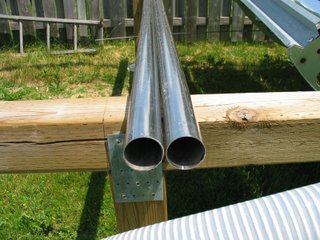 We are swimming regularly now and the pool temperature is holding about 76 degrees F, thanks to the home built parabolic tracking solar collectors and the pool blanket.
We are swimming regularly now and the pool temperature is holding about 76 degrees F, thanks to the home built parabolic tracking solar collectors and the pool blanket.Here you can see the six collectors currently installed (click any picture to enlarge it). The mirrors are linked together mechanically and pivot around the collector tubes to focus the sun onto the tubes. Pushing or pulling on a single steel rod underneath moves them easily into position toward the sun. The reflectors are balanced, so it doesn't take a lot of force to move them.
Tracking the sun is still done manually. I go out to the collectors and move them every hour or so to get them back on the sun.
I am working on the automatic tracker, but the motor drive attached to a battery and a switch works well. No doubt there will be more heat collected when the automatic tracker is installed, probably this week.
Dust and leaves gather on the collector surfaces. No doubt the dust scatters the sunlight somewhat and cuts down on the heat reaching the collector tubes. The tilt of the collectors helps to wash them when it rains, but there hasn't been a lot of rain recently. I've tried washing them down with a sponge mop and a pail of water, but I will need to make a curved sponge to better fit the reflector surface and a longer handle, to reach the top of the collectors. If I'm not careful, I scratch the surface of the plastic mirrors.
We turn the pool pump off at night and on cloudy days to save energy. The pool pump uses a fair bit of electrical power since it is rated at 1 HP.
With the pump on and the collectors focused at the sun, everything is cool to the touch. The water flows so quickly that it only heats about a degree by the time it's gone through all six collectors.
If the pump isn't running and the collectors are focused at the sun things are a different matter, the water in the collector tibes will reach boiling within about half an hour. This will happen at least once a day as the sun passes overhead to wherever the collectors happen to have been left the previous day.
I'd done some tests on this previously and found that the boiling water expands down the pipe and back into the pool. Previously I'd had some problems with the compression fittings popping off the ends of the collector tubes so I added metal straps to hold them in place. No damage was caused to the plumbing I thought.
 I've included this picture to show the damage that occurred to one of the flex hoses due to the hot water. It has almost completely collapsed due to the heat. It was also leaking quite badly at the end nearest the collector tube that was the source of the heat.
I've included this picture to show the damage that occurred to one of the flex hoses due to the hot water. It has almost completely collapsed due to the heat. It was also leaking quite badly at the end nearest the collector tube that was the source of the heat.I've since replaced the tube with another type of flex hose. This is a fault condition only and shouldn't occur in normal use.
 I've also received my first two stainless steel collector tubes which I plan to build into the next two collectors over the next few weeks. The stainless, while not quite as good at heat conduction as the copper will have the advantage of not being attacked by the chlorine we must currently add to the pool water.
I've also received my first two stainless steel collector tubes which I plan to build into the next two collectors over the next few weeks. The stainless, while not quite as good at heat conduction as the copper will have the advantage of not being attacked by the chlorine we must currently add to the pool water.The glass sterilizer tube may allow us to do away with, or reduce the chlorine.
Also, with the recent rise in base metal prices, the stainless is now about the same price as copper.
It's time for a swim!
You might also be interested in https://georgesworkshop.blogspot.com/2015/08/pool-heating-2.html

3 comments:
I recently picked up some parabolic troughs that someone was getting rid of. They have a plexiglass cover. I noticed they were not sealed and had some residual moisture inside. I took the glass off and cleaned the glass and the troughs up and about to screw the glass back on. My question is should I seal them with a silicone around the edges to prevent moisture from getting in? Will this create too much pressure inside if they are sealed completely and cause damage to the glass or troughs?
I haven't seen what you have but in general, I recommend against a cover. You don't need it. It robs energy. If you are worried about a bit of moisture and dirt on the reflectors, see this
www.georgesworkshop.blogspot.com/2012/09/diy-solar-reflector-squeegee-from-car.html
Post a Comment